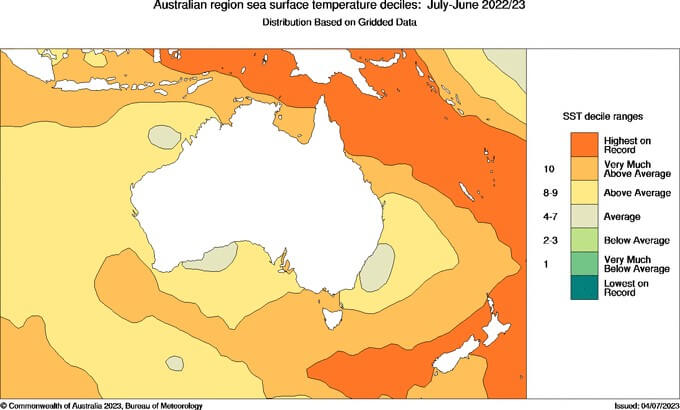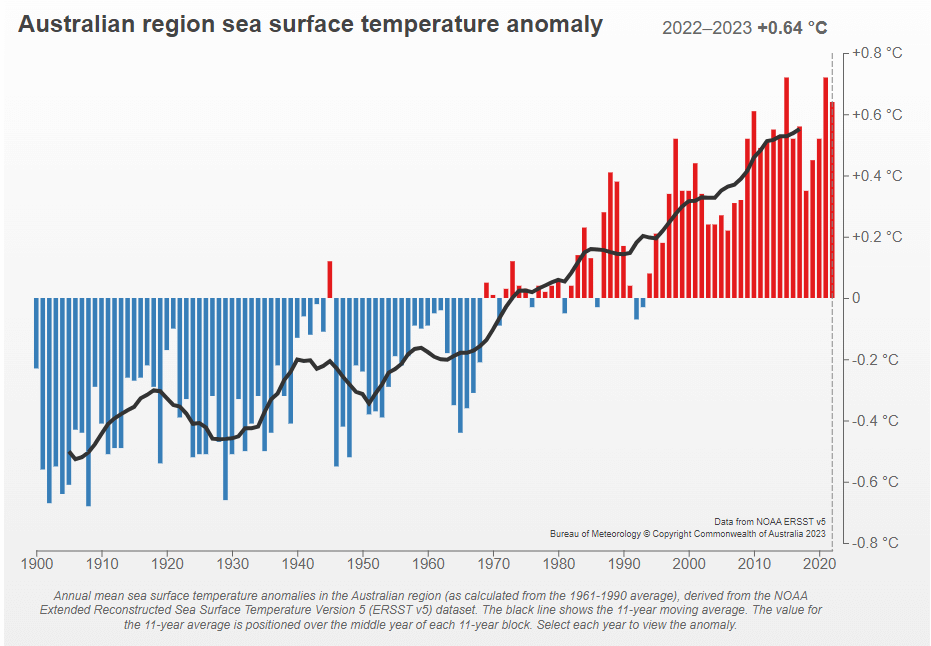Just like heatwaves on land, heatwaves occur in our oceans.
Marine heatwaves occur after a period of above average ocean temperatures and can have devastating impacts on marine wildlife, ecosystems and coral reefs.
The worst marine heatwave on record occurred in the northern Pacific Ocean killing one million seabirds.¹
The temperature of the ocean impacts everything from marine life, to coastal communities, to the stability of polar ecosystems and to weather events such as cyclones and floods.
In 2022–2023, the sea surface temperature around Australia was the third highest on record at 0.64 °C above the 1961–1990 average.²

Source: Bureau of Meteorology, 2023
When do marine heatwaves occur?
Marine heatwaves occur during hot, dry and windless conditions that make it impossible for hotter water in the upper layers of the ocean to mix with cooler water below. They are classified when warm sea surface temperatures last at least five days, and reach a temperature threshold considered well above the normal range.
Marine heatwaves are more likely to occur in El Niño years when extreme heat and drier conditions persist.
How is climate change impacting marine heatwaves?
Marine heatwaves are becoming more frequent, longer and dangerous due to climate change.
Climate change is caused by burning coal, oil and gas. Our oceans have absorbed around 90% of the trapped heat arising from fossil fuel emissions, which has led to global sea surface temperatures increasing over the 20th Century. Australia’s south-east ocean region is heating 3-4 times above the global average.³
Our oceans are bearing the brunt of climate change.
The frequency of marine heatwaves globally has doubled since 1982. Many parts of the ocean are predicted to reach a near-permanent marine heatwave state by the late 21st Century if fossil fuel emissions continue at high levels.⁴

Source: Bureau of Meteorology, 2023
Why are marine heatwaves bad for our oceans?
They cause heat stress, which can be lethal for temperature sensitive animals and plants.
Impacts include:⁵
- Slow the growth of some fish species
- Activate deadly viruses in infected oysters
- Stress immobile creatures like shellfish, oysters and abalone
- Cause kelp forests and seagrass meadows to collapse and release stored carbon dioxide back into the atmosphere. Australia’s giant kelp forests have declined by more than 90% due to ocean heating.
- Cause coral bleaching. Bleached corals can starve, get diseases or die if the temperature remains too hot for too long.
- Marine heatwaves have triggered coral bleaching on our Great Barrier and Ningaloo Reefs. The Great Barrier Reef has suffered four mass bleachings since 2016.

What other impacts do marine heatwaves have?
Marine heatwaves have significant economic and cultural impacts because human activities are so intrinsically linked to the ocean. Prolonged periods of unusually warm ocean can have severe repercussions on marine ecosystems and the fisheries sector, leading to:
- Loss of fish stocks resulting in losses of billions of dollars for our aquaculture sector and ocean fisheries
- Economic loss for our tourism industry – the Great Barrier Reef supports 64,000 jobs
- Damage or loss of significant cultural sites
- Impacts Aboriginal and Torres Strait Islander Peoples cultural activities and ability to care for sea Country
- Loss of iconic species that hold value to all Australians
- Loss of blue carbon ecosystems that store the carbon from fossil fuel emissions and cool our warming climate.
What are the solutions?
To help ease the pressure our oceans are facing from marine heatwaves, we must support sustainable fisheries and choose responsible seafood. Well managed sustainable fisheries limits the harm to ocean habitats and wildlife.
Extending our national network of Marine Parks is also critical to reduce stress on our marine ecosystems. Sanctuary zones within marine parks offer wildlife a refuge from the effects of climate change.
The best way to ensure our oceans’ future is to accelerate the global effort to cut emissions from burning coal, oil and gas.
The Australian government can show their determination to meet this challenge if they commit to:
- 100% renewables by 2030,
- Commit to an emissions reduction target of 75% by 2030,
- Commit to Net Zero by 2035,
- Commit to immediately ending the public funding and subsidies of coal, oil and gas,
- Commit to no further approval of fossil fuel infrastructure; and no new thermal coal, oil or gas projects